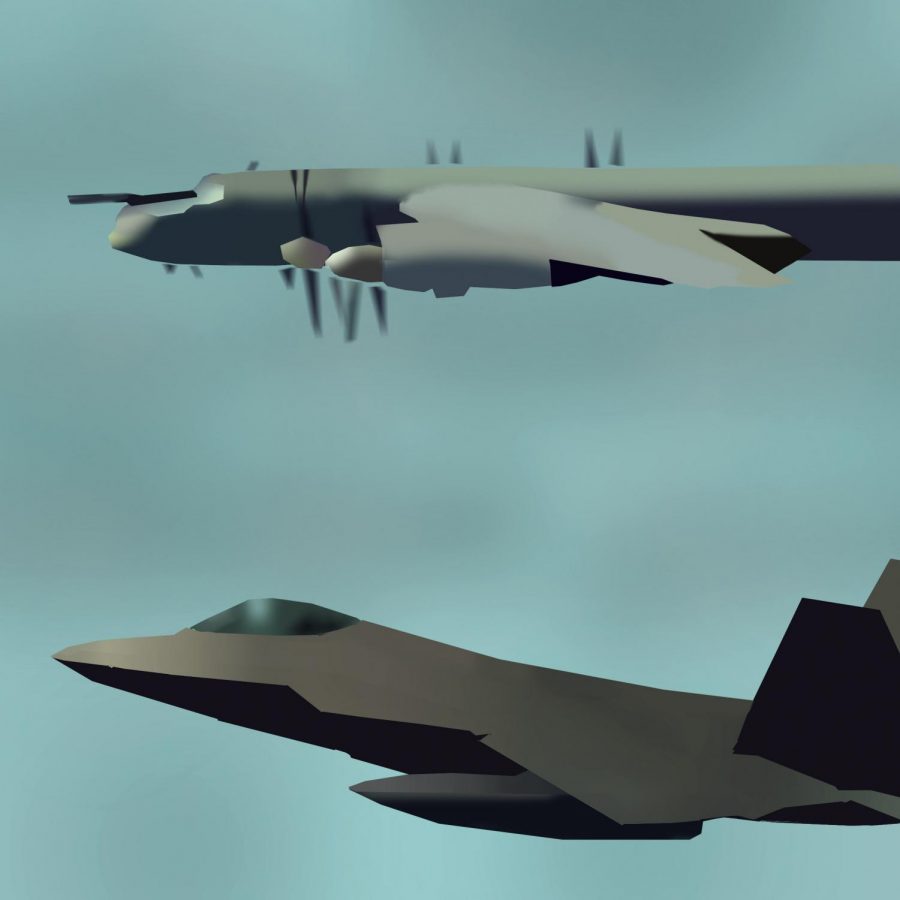The Cat and Mouse Game between the U.S. and Russia in the Sky
TENSION: A United States F-22 fighter jet intercepts a long range Russian bomber. Total flight time for the two interceptions exceeded 24 hours.
June 11, 2019
May 20, 2019, was a normal Monday for the average American. Many people in the United States attended work or school. Nothing of significance seemed to happen. Just a quiet peaceful day for the majority. However, what many people did not know was that there was an ongoing aerial standoff off the coast of Alaska. This standoff involved Russian and United States aircrafts. According to NBC News, “U.S. F-22 fighters intercepted four Russian bombers and two Russian fighter planes entering an area designated as the Alaskan Air Defense Identification Zone. The Russian bombers and fighters remained in international airspace and at no time did the aircraft enter United States or Canadian sovereign airspace.” It is very concerning to see another country flying near the United States with bombers and fighter jets, especially from Russia. Freshman Parker Watts says, “It is a matter of national safety. They should not be flying anywhere close to the United States.” Junior Kirsten Romero says, “It is kind of concerning. I have been hearing a lot of threats to domestic welfare recently.” Many students were unaware of the incident between the two countries. The Russian bombers and fighters were technically not doing anything wrong since they stayed in international airspace the whole flight which means they did not violate any international airspace regulations. However, the fact that they were flying so close the United States concerns many, especially with military aircraft.
Many people were relieved after finding about the altercation that ended peacefully on May 20. However, Russian bombers and fighter jets came back near the United States the next day. According to the ABC News, “For a second day in a row, U.S. Air Force F-22 fighters intercepted Russian aircraft that entered the Alaskan Air Defense Identification Zone (ADIZ). The Russian aircraft remained in international airspace and never entered U.S. airspace Tuesday, but this time, the Russian planes flew in and out of the Alaska Air Defense Identification Zone that stretches 200 miles from the Alaska coastline.” It seems like the Russian aircraft were trying to experiment with the first day to see if they could get attention. It appears that on the second day, the Russians were trying to prove a point with all the attention they were getting. This is evident through the Russian fleets bobbing and weaving through the Alaska Air Defense Identification Zone, basically calling for the United States air force to come over. It is difficult to figure out what the motives for the Russians were by flying near the United States two days in a row. Sophomore Zoe Zimmer says, “It is hard to figure out. It could be to try to strike fear to the United States, something is happening and they are trying to instigate that.” On the other hand, senior Aaron Susanto says, “They are doing this to attract attention, to start something up in the news and media.” It is interesting to see that Russia is trying to get attention.
Although there have been many air to air interceptions between the two countries in the past, these two incidents were the first in recent times. After a period of silence and peace in May, there was another incident in early June. According to the CNN News, “‘On June 4, 2019, a United States P-8A Poseidon aircraft flying in international airspace over the Mediterranean Sea was intercepted by a Russian SU-35 three times over the course of 175 minutes,’ the 6th Fleet said in a statement Tuesday.” The tides have turned. Now the Russians are intercepting the United States aircraft.
All three incidents involved the aircraft flying in international airspace. The CNN News states, “The Russian aircraft was armed and passed about 150 feet directly in front of the US plane according to two US officials. The Russian military on Wednesday disputed the US Navy’s characterization of the intercept as unsafe.” Although the Russian fighter jets were armed with missiles, the American ones that intercepted the bombers last May were most likely armed as well, since the missiles are there as a defense measure. However, the close high-speed pass made by the Russian fighter jet were not a very wise decision. According to the Independent, “The first and third interaction on Tuesday were deemed safe by the Navy, but the second interaction was ‘determined to be unsafe due to the SU-35 conducting a high speed pass directly in front of the mission aircraft, which puts our pilots and crew at risk.’” Flying past an aircraft at high speed is the same as driving past another car at high speed. They both are very risky maneuvers and can easily result in an accident. If the Russian fighter jet were to crash into the american aircraft by accident and cause casualties, it could go as far as to starting a war. It does not help that the Russian fighter jet performing the risky pass was armed with live ordinance and weapons. The Independent describes that “The crew of the U.S. aircraft reported wake turbulence following this unsafe interaction, which lasted approximately 28 minutes.” Wake turbulence is the disturbance that is created behind an aircraft as it flies through the air. Although the fighter jet is much more powerful than the American mission plane, the plane is bigger than the fighter jet so the wake turbulence caused by the fighter was more of an inconvenience rather than a threat to the crew’s safety.
All these “stand off” incidents are not good for foreign relations between Russia and the United States. There has already been lots of tension between the two countries, and the recent events have only heightened it. Solutions to prevent these incidents from happening again are difficult to find. Watts says, “There should be rules on flying on international waters when near other countries. There needs to be new laws and regulations to stop this type of intimidation from occurring again.” On the other hand, Zimmer says, “Trying to set more boundaries in international airspace could help with this issue, what can or cannot be flown. Certain types of aircraft or areas should be limited.”



